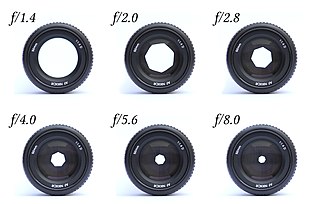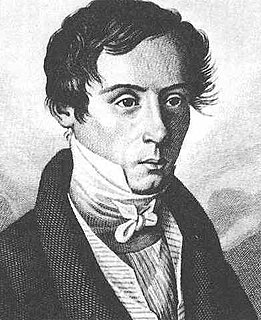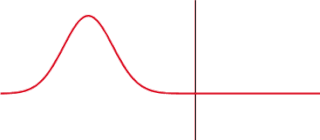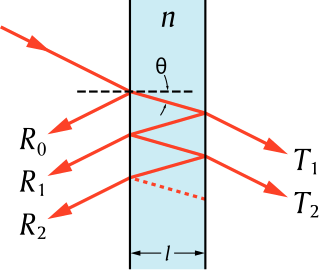 W
WIn physics, physical optics, or wave optics, is the branch of optics that studies interference, diffraction, polarization, and other phenomena for which the ray approximation of geometric optics is not valid. This usage tends not to include effects such as quantum noise in optical communication, which is studied in the sub-branch of coherence theory.
 W
WIn optics, the Airy disk and Airy pattern are descriptions of the best-focused spot of light that a perfect lens with a circular aperture can make, limited by the diffraction of light. The Airy disk is of importance in physics, optics, and astronomy.
 W
WIn optics, an aperture is a hole or an opening through which light travels. More specifically, the aperture and focal length of an optical system determine the cone angle of a bundle of rays that come to a focus in the image plane.
 W
WBrewster's angle is an angle of incidence at which light with a particular polarization is perfectly transmitted through a transparent dielectric surface, with no reflection. When unpolarized light is incident at this angle, the light that is reflected from the surface is therefore perfectly polarized. This special angle of incidence is named after the Scottish physicist Sir David Brewster (1781–1868).
 W
WFermat's principle, also known as the principle of least time, is the link between ray optics and wave optics. In its original "strong" form, Fermat's principle states that the path taken by a ray between two given points is the path that can be traversed in the least time. In order to be true in all cases, this statement must be weakened by replacing the "least" time with a time that is "stationary" with respect to variations of the path — so that a deviation in the path causes, at most, a second-order change in the traversal time. To put it loosely, a ray path is surrounded by close paths that can be traversed in very close times. It can be shown that this technical definition corresponds to more intuitive notions of a ray, such as a line of sight or the path of a narrow beam.
 W
WA focal cloud is the collection of focal points of an imperfect lens or parabolic reflector whether optical, electrostatic or electromagnetic. This includes parabolic antennas and lens-type reflective antennas of all kinds. The effect is analogous to the circle of confusion in photography.
 W
WA frequency-selective surface (FSS) is any thin, repetitive surface designed to reflect, transmit or absorb electromagnetic fields based on the frequency of the field. In this sense, an FSS is a type of optical filter or metal-mesh optical filters in which the filtering is accomplished by virtue of the regular, periodic pattern on the surface of the FSS. Though not explicitly mentioned in the name, FSS's also have properties which vary with incidence angle and polarization as well - these are unavoidable consequences of the way in which FSS's are constructed. Frequency-selective surfaces have been most commonly used in the radio frequency region of the electromagnetic spectrum and find use in applications as diverse as the aforementioned microwave oven, antenna radomes and modern metamaterials. Sometimes frequency selective surfaces are referred to simply as periodic surfaces and are a 2-dimensional analog of the new periodic volumes known as photonic crystals.
 W
WThe Fresnel equations describe the reflection and transmission of light when incident on an interface between different optical media. They were deduced by Augustin-Jean Fresnel who was the first to understand that light is a transverse wave, even though no one realized that the "vibrations" of the wave were electric and magnetic fields. For the first time, polarization could be understood quantitatively, as Fresnel's equations correctly predicted the differing behaviour of waves of the s and p polarizations incident upon a material interface.
 W
WA Fresnel rhomb is an optical prism that introduces a 90° phase difference between two perpendicular components of polarization, by means of two total internal reflections. If the incident beam is linearly polarized at 45° to the plane of incidence and reflection, the emerging beam is circularly polarized, and vice versa. If the incident beam is linearly polarized at some other inclination, the emerging beam is elliptically polarized with one principal axis in the plane of reflection, and vice versa.
 W
WAugustin-Jean Fresnel was a French civil engineer and physicist whose research in optics led to the almost unanimous acceptance of the wave theory of light, excluding any remnant of Newton's corpuscular theory, from the late 1830s until the end of the 19th century. He is perhaps better known for inventing the catadioptric (reflective/refractive) Fresnel lens and for pioneering the use of "stepped" lenses to extend the visibility of lighthouses, saving countless lives at sea. The simpler dioptric stepped lens, first proposed by Count Buffon and independently reinvented by Fresnel, is used in screen magnifiers and in condenser lenses for overhead projectors.
 W
WIn optics, a Gaussian beam is a beam of monochromatic electromagnetic radiation whose amplitude envelope in the transverse plane is given by a Gaussian function; this also implies a Gaussian intensity (irradiance) profile. This fundamental (or TEM00) transverse Gaussian mode describes the intended output of most (but not all) lasers, as such a beam can be focused into the most concentrated spot. When such a beam is refocused by a lens, the transverse phase dependence is altered; this results in a different Gaussian beam. The electric and magnetic field amplitude profiles along any such circular Gaussian beam (for a given wavelength and polarization) are determined by a single parameter: the so-called waist w0. At any position z relative to the waist (focus) along a beam having a specified w0, the field amplitudes and phases are thereby determined as detailed below.
 W
WThe Gerchberg–Saxton (GS) algorithm is an iterative algorithm phase retrieval algorithm for retrieving the phase of a complex-valued wavefront from two intensity measurements acquired in two different planes. Typically, the two planes are: the image plane and the far field (diffraction) plane, and the wavefront propagation between these two planes is given by the Fourier transform. The original paper by Gerchberg and Saxton considered image and diffraction pattern of sample acquired in an electron microscope.
 W
WThe term plane of polarization refers to the direction of polarization of linearly-polarized light or other electromagnetic radiation. Unfortunately the term is used with two contradictory meanings. As originally defined by Étienne-Louis Malus in 1811, the plane of polarization coincided with the plane containing the direction of propagation and the magnetic vector. In modern literature, the term plane of polarization, if it is used at all, is likely to mean the plane containing the direction of propagation and the electric vector, because the electric field has the greater propensity to interact with matter.
 W
WRadius of curvature (ROC) has specific meaning and sign convention in optical design. A spherical lens or mirror surface has a center of curvature located either along or decentered from the system local optical axis. The vertex of the lens surface is located on the local optical axis. The distance from the vertex to the center of curvature is the radius of curvature of the surface.
 W
WReflection is the change in direction of a wavefront at an interface between two different media so that the wavefront returns into the medium from which it originated. Common examples include the reflection of light, sound and water waves. The law of reflection says that for specular reflection the angle at which the wave is incident on the surface equals the angle at which it is reflected. Mirrors exhibit specular reflection.
 W
WIn physics and electrical engineering the reflection coefficient is a parameter that describes how much of a wave is reflected by an impedance discontinuity in the transmission medium. It is equal to the ratio of the amplitude of the reflected wave to the incident wave, with each expressed as phasors. For example, it is used in optics to calculate the amount of light that is reflected from a surface with a different index of refraction, such as a glass surface, or in an electrical transmission line to calculate how much of the electromagnetic wave is reflected by an impedance. The reflection coefficient is closely related to the transmission coefficient. The reflectance of a system is also sometimes called a "reflection coefficient".
 W
WIn physics, refraction is the change in direction of a wave passing from one medium to another or from a gradual change in the medium. Refraction of light is the most commonly observed phenomenon, but other waves such as sound waves and water waves also experience refraction. How much a wave is refracted is determined by the change in wave speed and the initial direction of wave propagation relative to the direction of change in speed.
 W
WSignal reflection occurs when a signal is transmitted along a transmission medium, such as a copper cable or an optical fiber. Some of the signal power may be reflected back to its origin rather than being carried all the way along the cable to the far end. This happens because imperfections in the cable cause impedance mismatches and non-linear changes in the cable characteristics. These abrupt changes in characteristics cause some of the transmitted signal to be reflected. In radio frequency (RF) practice this is often measured in a dimensionless ratio known as voltage standing wave ratio (VSWR) with a VSWR bridge. The ratio of energy bounced back depends on the impedance mismatch. Mathematically, it is defined using the reflection coefficient.
 W
WA spatial filter is an optical device which uses the principles of Fourier optics to alter the structure of a beam of light or other electromagnetic radiation, typically coherent laser light. Spatial filtering is commonly used to "clean up" the output of lasers, removing aberrations in the beam due to imperfect, dirty, or damaged optics, or due to variations in the laser gain medium itself. This filtering can be applied to transmit a pure transverse mode from a multimode laser while blocking other modes emitted from the optical resonator. The term "filtering" indicates that the desirable structural features of the original source pass through the filter, while the undesirable features are blocked. Apparatus which follows the filter effectively sees a higher-quality but lower-powered image of the source, instead of the actual source directly. An example of the use of spatial filter can be seen in advanced setup of micro-Raman spectroscopy.
 W
WTotal internal reflection (TIR) is the optical phenomenon in which the surface of the water in a fish-tank when viewed from below the water level, reflects the underwater scene like a mirror, with no loss of brightness (Fig. 1). In general, TIR occurs when waves in one medium reach the boundary with another medium at a sufficiently slanting angle, provided that the second ("external") medium is transparent to the waves and allows them to travel faster than in the first ("internal") medium. TIR occurs not only with electromagnetic waves such as light and microwaves, but also with other types of waves, including sound and water waves. In the case of a narrow train of waves, such as a laser beam (Fig. 2), we tend to describe the reflection in terms of "rays" rather than waves. In a medium whose properties are independent of direction, such as air, water, or glass, each "ray" is perpendicular to the associated wavefronts.
 W
WThe transfer-matrix method is a method used in optics and acoustics to analyze the propagation of electromagnetic or acoustic waves through a stratified medium. This is for example relevant for the design of anti-reflective coatings and dielectric mirrors.
 W
WThe transmission coefficient is used in physics and electrical engineering when wave propagation in a medium containing discontinuities is considered. A transmission coefficient describes the amplitude, intensity, or total power of a transmitted wave relative to an incident wave.